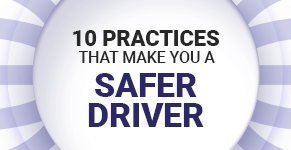Access blogs, quizzes, and the latest driving updates at your fingertips!

If you get sweaty palms just thinking about parallel parking, trust us, you are not the only one. Many drivers feel the same pressure when they have to align and park the car without causing any damage to other cars.
Parallel car parking is a hard skill to master because of how intricate it is. And yet, it is an essential driving manoeuvre that you must know of to park in tight spaces that you encounter in day to day driving.
Here is all that you need to know about parallel parking, which along with the on-road practice, will help you master the art with ease.
Parallel parking is a method of parking a car in line with other parked vehicles on one side of the road and facing in the same direction as traffic on that side. To do this, one has to slightly drive past the available parking space and pull up next to the parked vehicle, then gradually reverse to fit in the space whilst keeping a safe distance.
This may sound a little tricky, but there is no need to get nervous. With concentration and some practice, one can easily master the technique of parallel car parking.
Being a precise driving manoeuvre, parallel parking hinges on following the right approach. Here are the four steps to parallel park your car.
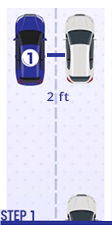
In parallel parking, you should not just park in the very first space spotted. It requires careful analysis of the available parking space to see if your car will fit there. As a thumb rule, the parking space should be one and a half times the length of your car. Only then should you pull up or else keep looking until a suitable space is available. Once the right spot is found, stop your car parallel to the car you are going to park behind. Maintain a distance of 2-3 feet while doing so.
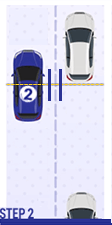
Next, slowly reverse until the middle part of your car is parallel to the other vehicle's rear bumper. At this point, your car will start changing direction to slot behind the car in front. The benefit of maintaining distance will become evident here; you'll have enough space to reverse without risking any contact between your car and the other vehicle.
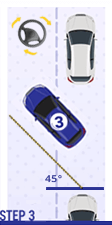
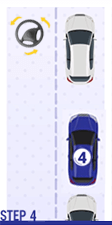
Now, cut the steering wheel towards the right to achieve a 45° angle and continue in reverse gear. Then, turn the steering wheel anti-clockwise and continue reversing until your car is perfectly aligned with the rest of the vehicles, and parallel to the wall or divider on the driver's side.
Note: The same approach will be applicable when you are parallel parking your car on the left. In this case, the left side of your car will be parallel to the wall, divider or any such boundary.
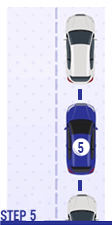
The final step is to check if your car is at an equal distance from the cars in front and behind, and the edge of the road. If not, then reposition your car until it is in the center and demonstrates perfectly parallel lines.
Is it surprising for you to see other drivers flawlessly parallel park their car? Here are the 5 must-know parallel parking tips to help you get there.
Always keep your indicator (whether left or right) switched on while you are parallel parking the car to let other drivers know about your intended turn. Remember that this is the only way to communicate with other vehicles on the road. Hence, use your indicators wisely while parallel parking your car.
There are quite a few possibilities of blind spots when parallel parking. Hence, always keep an eye on both using your IRVM (Inside Rear View Mirror) and ORVMs (Outside Rear View Mirror) to check for any risks or obstacles while reversing the car.
Rushing is never a good idea on the road especially when parallel parking. Keeping in line with the thought, slowly and gradually reverse your car as you slot your car into the empty parking space.
Parallel parking is all about how swiftly and smartly you turn the steering wheel whilst having full control of it. Remember to place your hands in the nine and three-position at all times and let the wheel spin freely with both your hands on it as much as possible to maintain good control.
While keeping your car as close to the wall or divider as possible, you also need to ensure that there's ample room left in front and behind for other vehicles to easily pull in and out of their respective parking spaces without the risk of damage.
When the divider or wall is on the driver side while parallel parking, leave enough room for the right side doors to open for you and your co-passengers to get in and out.
Remember, the more you practice using these tips to parallel park, the easier it becomes to master the art without any sweaty palms or the risk of bumping into other parked cars while you are parallel parking your car.
Although the 2020 lockdown resulted in a 49..47% fall in the number of lives lost in road accidents (April - June, as compared to numbers from 2019) [source], the fact remains that there's still a lot of effort required. To make that happen, one must become a responsible driver and inculcate driving practices that help maintain safety for one and all on the road.
Driving is an art that needs to be mastered with focus and discipline. Whether you are a new driver who wants to learn how to drive a car or among the experienced drivers who want to brush up their skills, choosing a professional driving school is always a good idea.
Helping you master safe and responsible driving, Maruti Suzuki Driving Schools are equipped with the best-in-class facilities, expert trainers, a well-balanced curriculum, and much more, which makes the learning experience even more amazing.
Let's get to the tips that can help you become a safer driver: -
Confidence is everything when it comes to driving. The more confident you are, the better control you will have over your driving. If you already know how to drive but are not that confident when it comes to hitting the roads, you can opt to join an advance driving course. It will help you gain the confidence you need to have to become a good driver.
Ensuring that your car is kept in a good condition is very important. It can help you avoid a number of adverse situations on the move. For example, worn out tires are not only prone to punctures but may even end up exploding, causing a car to swerve uncontrollably. Other good practices include making sure that the oil levels of the car are up to the mark and maintaining proper tire pressure while driving, among others.
No matter how confident you are about your driving, no matter how short the distance that you are travelling, you should always make sure that you put on your seatbelt. Even if your car has airbags, it does not mean that you can forget about your seatbelt.
You can never control how others drive on the road. They may be inexperienced, ignorant of the rules, having an emergency, or just having a bad day! It is up to you to avoid such situations. Become well-versed in defensive driving and hold your own if faced with something like this.
This is one of the most important aspects of being a safer driver. You need to know about the rules and regulations that your state/country has in place. That way, you can maintain road safety and help ensure smooth mobility. When you join a professional driving school, your curriculum will cover theory classes as well as practical sessions. So, make sure you pay attention to what is taught in class. It will help you when you get behind the wheel by yourself.
Driving fast may seem like an exciting experience but safe driving is always the better choice. One of the most crucial things that you need to keep in mind is responsible driving. Never exceed the given speed limit and always ensure to keep an eye on your speedometer. Driving within the speed limit is not only safer for you but also for the other people on the road.
Another important thing to keep in mind is that no matter how boring traffic jams may get, you should not weave between lanes. Weaving between the lanes more often than not leads to more chaos in the traffic rather than helping you make your way out of it. Patience is a virtue when it comes to driving in the city.
Another important safety practice, always ensure that you use your indicators when you are going to change the lane, make a right or left turn, and so on. Indicators are a way for drivers to communicate with other drivers on the road, keeping them alert about where you'll turn so that they can maintain a safe distance.
To become a safer driver, you need to keep the distractions at bay. So, before you start driving the car, connect your smartphone to Bluetooth or the infotainment system, which will let you stay updated on the go and you can keep your eyes and focus on the road even if you have to answer a call. Adjust your seat and mirrors in a position you are comfortable with so you don't have to be distracted with adjustments when driving.
If you feel sleepy, getting behind the wheel may not be the best idea. Drowsiness can impair your driving abilities, making you a hazard on the road, not only for yourself but for others as well. If you simply have to get somewhere, either get someone else to drive or take a cab.
The onus to drive safely and responsibly is in your hands and these good practices help ensure that. Imbibe and make them a part of your daily driving routine to set the right example for others on the road.
In order to be a good driver, one must always equip oneself with all the theory lessons while learning to drive. And one of the best ways to do it is by enrolling in a driving school. Tangible benefits for an educated driver include saving close to 12% of fuel related expenses and 60% when it comes to safety related faults.
A good driving school will make sure that the participants are equipped to handle emergencies, use first aid, react correctly for situations emerging on roads like road rage incidents, aware of the symbols lighting up on the car’s instrument cluster, and honouring the rights of others on the road.
Here are some of the most crucial aspects that highlight the importance of theory lessons while learning to drive.
Theory lessons often include all those aspects of owning and driving a car that can only be learnt through classroom input. A good driving school appoints experts to teach the theory lessons. These experts communicate effectively and give attention to each participant. The practical lessons learnt from the driving-coach need to be backed with theoretical knowledge if you want to be a confident driver. At Maruti Suzuki Driving School, we ensure that our instructors are focused on helping the learners develop the skills required to drive safely and confidently.
A carefully designed curriculum of a driving school covers a wide range of topics. A lot of these topics are about the inner workings of a vehicle that includes technical details of how a car functions. Some of the most crucial aspects of theory input are identifying the traffic rules and all the important signs, symbols, indications, map-legends/keys and several other nuances which are not always present at one-go during the practical lessons on the road.
Theory lessons in a driving school also focus on several legal aspects. A participant is made aware of the process of registration of a vehicle, obtaining a driver's license, traffic rules, parking rules, towing rules, suspension of driver's license, drunken driving, rash and negligent driving and most importantly the penalties for traffic offences. Trainees are also educated on different types of insurance covers available, their pro and cons, and the procedure to be followed for claim processing.
Safe roads are the hallmark of a civilized society. Our love for driving is always tested on the touchstone of traffic rules. A good driver diligently follows traffic rules to ensure safety. Maruti Suzuki Driving School emphasizes the importance of safe driving by not only teaching the theory lessons but also exposing the learners to simulators. Theory input shows the details of the safety features of a car and how to use those features. We share the road with every other driver, therefore, it is mandatory to learn the rules of safe driving
Theory lessons introduce the learner to the structure of a car including all of its important components. This knowledge is necessary in order to drive confidently. These lessons are interesting and helpful. Learners are taught about the most important aspects of a car engine, chassis, crank linkage, fuel supply system, cooling mechanism, lubrication, ignition, starting line, clutch, brake system, gears, battery etc. Experts often show the link between the structure of a car and the rules of driving. For instance, an expert driver can reduce gearbox repairs by up to 40%. Learners are encouraged to apply the theory to their driving sessions on the road. This process helps build confidence through awareness of traffic rules and safe driving skills.
We must always remember that the right to drive can only be enjoyed if we are responsible drivers. The responsibilities of a driver are learnt in detail through theory lessons. These rights and responsibilities are codified in the form of important laws such as the Rules of Road Regulations and Motor Vehicles Act. These codes prescribe punishments for violation of the rules.
It is our sincere endeavour to create confident drivers who believe in safe driving. We have designed a Learner's Course which spans 21 hours, including 10 hours of practical and 11 hours of theory input. Our carefully designed theory lessons ensure that the driver not only has excellent driving skills but also sound knowledge of theory.
